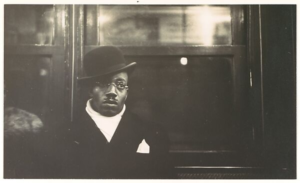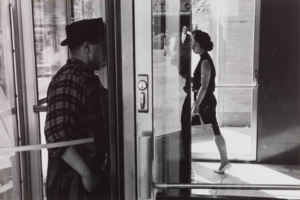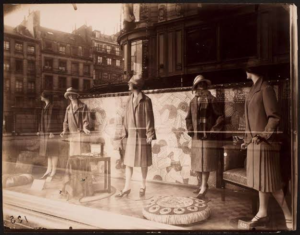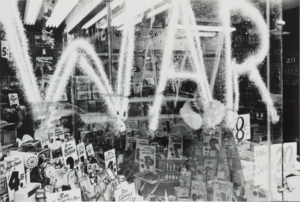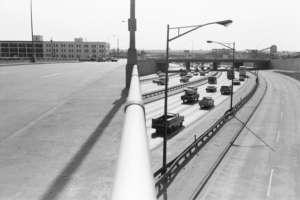Between machine and eye
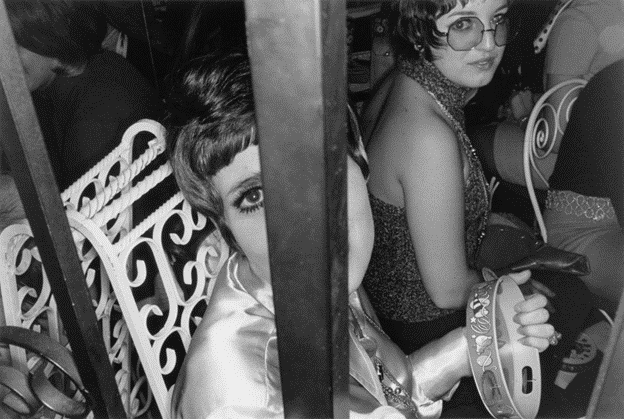
LEE FRIEDLANDER New York City, 1969. gelatin silver print
© Lee Friedlander, courtesy Fraenkel Gallery, San Francisco and Luhring Augustine, New York
This photograph is the kind of photograph you’d throw away. If you’re working with a digital camera, you would immediately delete it. It’s a disaster. Trash it and move on. There’s a big metal bar in the middle of the shot. It must be from a gate or something. The metal bar not only dominates the very center of the picture, it’s also so close to the camera that the bar is blurred at the top. Technically speaking, that is a no-no. This is a terrible photograph.
And yet, the very thing that seems at first so terrible is what makes the picture so compelling. If the obscuring bar wasn’t there, we would know too much, visually speaking, about the woman behind the bar. As it is, she is obscured in just the right way. Her one looming and seemingly unblinking eye gets all the attention it needs and deserves. The woman further in the background, with her timid glance and questioning mouth, only heightens the self-assured intensity of the giant eye.
Look closer. There is another bar-obscured face to the left of the giant eye and a headless torso to the top right. There is a plethora of metal, turned and shaped in different kinds of designs. In some ways, the photo is a study of the way that iron and iron-like substances can be both hard and soft, dominating and decorative at the same time. It is also, you could argue, a photo about the different shapes that can be made with human hair. Sweeping, sculptural, wispy.
And it will always be a great portrait of the human eyeball. The thing that sees. The thing that is seen. Perhaps the most mysterious spherical thing in the universe. What is one ever really looking at when one looks into an eye?
So, we have a photograph that seems like a mistake but is also impossibly compelling. The photograph is a glorious accident.
And that is the tantalizing doubt attached to photographs like this, photos that come from the tradition sometimes called street photography or even snapshot photography. Is there photographic skill here, a mastery being displayed by those who take these kinds of photos? Couldn’t this photo have been taken by someone who had no special skill in photography at all?
In fact, the photograph was taken by Lee Friedlander, one of the more celebrated photographers of the last sixty years. And this photograph, in particular, was recently exhibited in a show curated by the filmmaker Joel Coen. More on this later.
For now, back to the central conundrum of photography, art, and skill.
===
How much skill does it actually take to be a photographer? Is photography really and truly an art? These questions about photography – what it is, what it does – have been with us since the first photographic images were produced in the early 19th century. Photographic gear in the pre-digital era was a lot more cumbersome than it is today. But even the earliest photography—with its bulky lenses and slow exposure times, the creepy black hood under which the photographer had to hide—amounted to a radical democratization of the image-making process. No longer did artists have to have special painting skills or materials to make a picture. You only had to have a bit of technical know-how and some relatively expensive equipment. Then just point and click.
Thus, the existential problem of photography from the very beginning. Is it art or not? Does the fact that almost anyone can do it make it less than the finer arts like painting or sculpture? This problem keeps returning and photography has never solved it in any definitive way. It is probably unsolvable.
But the dilemma got even more extreme in the 1950s and 60s. Some people say it started with Walker Evans, actually. Already back in the late 1930s, Evans rigged up a kind of secret peepshot apparatus whereby he could snap photos of people on the subway without them realizing he was taking a picture. One could probably get arrested for such a thing these days. But back in the 1930s, the worries about such violations of privacy were still in their infancy. These photos are especially notable in that Walker just had to position himself more or less in front of his victim and click. He didn’t know how the framing was going to turn out. He was more or less winging it. The photos are, nonetheless, often quite striking.
Walker Evans, Subway Portrait (January, 1941).
There is a tough question here, though. Even tougher than the questions that were already being asked about photography. Because in this new, semi-random catch-as-catch-can approach to photography, the removal of any particular technical skill is further heightened. Walker himself had no idea how most of these pictures were going to look until he developed them.
As the decades progressed, cameras got cheaper and smaller and simpler, making it possible for nearly anyone to take a Walker Evans-style snapshot picture. This ease and immediacy democratized picture-taking quite radically. And you could then get your film developed in a couple of days, or —in the later part of the century–just a couple of hours. Today, with digital cameras, the image is available instantly.
A number of so-called fine art photographers in the second half of the century began fully to embrace this random ‘snapshoty’ aspect of photography and, moreover, to claim it specifically as a form of high art. The MoMA curator John Szarkowski had much to do with this. He championed a number of artists who went out into city streets, capturing scenes of daily life. In 1967, Szarkowski organized an exhibit that truly marked an era. It was called “New Documents” and featured the work of Diane Arbus, Garry Winogrand, and Lee Friedlander. All three of these photographers would become famous, but they were basically unknown when Szarkowski put them in the show. As Szarkwoski wrote in the press release for the exhibit, “What unites these three photographers is not style or sensibility; each has a distinct and personal sense of the use of photography and the meanings of the world. What is held in common is the belief that the world is worth looking at, and the courage to look at it without theorizing.”
Which is to say that they were snapshot photographers, and that they were embracing snapshot photography as a form of art.
===
Lee Friedlander was born in Aberdeen, Washington in 1934 and studied photography at the Art Center College of Design in Pasadena. From there he headed out to New York City, where he eventually caught the eye of John Szarkowski and was included in the “New Documents” exhibit. Friedlander always seemed especially attracted to street scenes and the busy visual information of New York City in particular. He strolled around the city with his Leica 35mm camera shooting almost exclusively in black and white.
Lee Friedlander, New York City (1963)
His images could, like the one directly above, be so complex as to be confusing. The multiplication of reflections make this shot something like a visual puzzle. Friedlander once wrote, “The camera is not merely a reflecting pool and the photographs are not exactly the mirror, mirror on the wall that speaks with a twisted tongue.” It’s a comment almost as confusing as the photographs. On the other hand, we know what he means. The camera shows us something. But what it shows is that the images we observe during our daily confrontations with the world are, when interrogated with any rigor, fraught with contradictory and overlapping visual messages. Surfaces are more than surface. A simple glance at the world can be baffling and extraordinary. It isn’t that the world makes no sense, exactly, but more like the world makes too much sense. Most of the time, we’re forced to block much of this complexity out just to get around in the world. Friedlander’s photographs force us to go back and face the convoluted multiplicity of visual experience, especially in the richness of the urban landscape.
That’s why Lee Friedlander is often discussed as the mid-20th century heir to the work of Eugène Atget. Atget photographed early 20th century Paris with much of the same love for its visual intricacy as Friedlander found in the New York City of his time.
Eugène Atget, Bon Marché (1926-7)
Here, for instance, is an Atget picture that is, in some sense, the ancestor to Friedlander’s photo just above. We’re looking at a shop window but we’re also just as much looking at the buildings reflected in the window. The reflection is causing a visual effect whereby the mannequins could almost be walking on the street outside. And there is a ghostlike quality to the shot for that reason. Cities, with all their visual overload, throw up a series of tricks, mirages, illusions. One could react to this fact with fear and mistrust. But that’s not what we see in Atget’s pictures. Instead of retreating to criticism or a place of more solid visual ground, Atget threw himself into the wonder of these disorienting experiences.
That’s what Szarkowski was talking about when he said that the photographers he chose for the “New Documents” show felt that “ the world is worth looking at,” and that they had “the courage to look at it without theorizing.” Szarkowski was drawing a contrast between some of the most important photographers of the previous generation, like Walker and Dorothea Lange, who took pictures of America during the Depression years that were meant to evoke a moral and political response. Those photographers went out to frame pictures that would illustrate an idea. Friedlander, by contrast, was just going out into the world and letting things happen, letting images come to him, without any preconceived agenda about art or politics or anything else.
This is a somewhat tricky point to make, since 1960s America was no less embroiled in socio/political problems and controversies than it had been in previous years. It could not fairly be said that Friedlander was indifferent to this fact.
Lee Friedlander, War (circa 1965)
This circa-1965 photograph entitled War is a case in point. Paying attention to the urban landscape of the 1960s also meant paying attention to visual content that was itself political, like that surrounding the Civil Rights movement, the Vietnam War, the Women’s movement, etc. Friedlander’s photograph seems to reflect, no pun intended, this reality. Then again, we’re not sure what the word ‘WAR’ is doing here. It could mean anything, or nothing. The word is simply startling and brash against the softer, if no less pleading information about products and prices behind the window. This is a photograph that looks and shows. It wants us to look as well, to take in what is being shown. But it doesn’t want us to have any particular thought. It is not making a statement. And it’s only after looking at the picture for some time that we realize there is a person in the photograph— a young woman whose reflection we can see in the bottom corner of the ‘A’ of ‘WAR’. She barely exists within the cacophony of information that the picture contains. But she is there.
Maybe, in the end, that’s the best explanation of why Lee Friedlander is such a good photographer. He knows how to look when something interesting is happening. He trusts himself to point the camera and click. Why is he so much better at doing this than most of us? It’s impossible to say. But the pictures are not great because of any particular technical skill or brilliant idea. Friedlander has stated in interview after interview that he isn’t especially bright and has no ideas. He is being coy, of course. But we can take him more or less at his word. He isn’t driven by thoughts or concepts or formal principles. He isn’t claiming the ability to do something that anyone else with a camera in the street couldn’t do. If he trusts in anything, it’s in his physical body, which knows just how to step into the right spot at the right moment and then let the camera do the rest.
===
For those delighted by the unique, if mysterious quality of Friedlander’s photographic vision, one of the better art exhibits of 2023 was a smallish exhibit at the Fraenkel Gallery in San Francisco. I should say that I didn’t actually see the exhibit in person. I am working from documents and a pdf of the book that was published out of the exhibit. The exhibit was titled Lee Friedlander Framed by Joel Coen. The organizers of the exhibit asked the famous film director to choose a selection of Freidlander shots he especially liked, or that especially jumped out at him.
The most delightful thing to me about the book, which contains more photographs than the original exhibit, is that it contains hardly any words. Joel Coen wrote a two paragraph introduction. Frances McDormand wrote a several-paragraph afterword entitled Lee and Joel, Observed. Neither of those pieces of writing are particularly revealing, and they don’t need to be. Joel Coen wrote, “And as a filmmaker, I liked the idea of creating a sequence that would highlight Lee’s unusual approach to framing — his splitting, splintering, repeating, fracturing, and reassembling elements into new and impossible compositions.”
Those are exactly the kinds of shots that Coen chose for the exhibit and the book. Tons of pictures with unusual framings. More than anything, Coen seems to love Friedlander pictures where the photograph is split in two by some sort of tree or pole or other thin vertical object. These pictures have a kind of brutality to them, since the continuous experience one often expects from a picture is completely discarded. Instead, we get pictures that look like they’ve broken apart somehow, or never quite fit together in the first place.
My personal favorite is a picture titled Dallas, 1977.
LEE FRIEDLANDER Dallas, 1977 gelatin silver print.
© Lee Friedlander, courtesy Fraenkel Gallery, San Francisco and Luhring Augustine, New York
Like the photograph of the woman we looked at earlier, this photograph is poorly framed according to any Photography 101 class you might take. The pole in the middle ruins everything. But that’s precisely the point. The pole is bothersome and that bother forces you to notice the essential strangeness of this image. It’s like two worlds exist simultaneously. The world on the left half of the picture is so placid and empty. The world on the right is crowded and busy. And yet they’re the exact same world. Aren’t they?
I’m not sure what this photograph ‘means’ or even why it is art. As McDormand mentions in her short afterward to the book, photographs like this are just something that makes you go ‘huh’. But we go ‘huh’, I would say, because Friedlander is able to capture something we all experience. We all go about our daily business confident in the fact that one side of the street is continuous with the other side, that people don’t materialize directly out of poles and lampposts, that what we are seeing corresponds to some coherent reality. And we also receive constant information reminding us that this is not the case, that our brains are, in some sense, constructing a reality that isn’t really there. Or at least, not ‘there’ in exactly the way we present it to ourselves. And our constructed reality constantly reveals the seams and gaps and glitches of this false narrative. Friedlander’s pictures, especially the ones Coen was drawn to, are deeply attentive to this double reality.
In the end, the question of photography as an art or a technical skill, of what makes one person’s snapshot worthy of a show in a gallery or museum and another’s ‘just’ a snapshot is impossible to answer with any rule or criterion. As John Szarkwoski once wrote, “A camera has interesting ideas of its own.”
In essence, the genius of Friedlander’s photography is to let the camera have its own ideas. The photograph we opened up with, the giant eye and the face half-obscured behind a metal bar, is a picture that the camera ‘decided’ to take just as much as Lee Friendlander. Sorting out exactly how much it was an accident or not misses the point. It was, more interestingly, a kind of collaboration. Friedlander trusted the camera enough to let it show him things he might not otherwise have been able to see, something perhaps like what the less-organized flood of data coming into the eye looks like before the brain organizes this data into a more coherent picture. Seeing this image just at the cusp between chaos and coherence is inherently compelling. But it takes the machine-eye of the camera to make this magic happen.
That’s the unsettling truth of the matter. The art of photography is in some important way the art of the machine. What happens between machine and world is a magic that we witness more than create or control. The history of photography has been, in a sense, the progressive surrender to this basic truth. Looked at in this way, Lee Friedlander is a witness just like the rest of us. Only a little bit more so.

